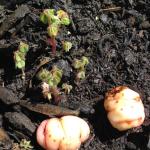Growing Yam/Oca, also Oka
Oxalis tuberosa : Oxalidaceae / the wood sorrel family
| Jan | Feb | Mar | Apr | May | Jun | Jul | Aug | Sep | Oct | Nov | Dec |
|---|---|---|---|---|---|---|---|---|---|---|---|
| P | P | P |
(Best months for growing Yam/Oca in Australia - sub-tropical regions)
- P = Plant tubers
- Plant tubers about 5cm (1.5") deep covered with soil. Best planted at soil temperatures between 17°C and 35°C.
- Space plants: 30 - 45 cm apart
- Harvest in 15-20 weeks. Leave in the ground until foliage has completely died down so tubers reach maximum size.
- Compatible with (can grow beside): Best in separate bed
Yams needs a long growing time to produce the tubers.
Protect from early Autumn (Fall) frosts to give time for tubers to fully develop.
Planting needs are similar to potatoes. Yams can handle more shade than potatoes. Earthing up will help increase production.
The leaves look rather like clover. Dig up after the plant dies down and leave outside for a few days to dry.
Culinary hints - cooking and eating Yam/Oca
Scrub and boil or roast with other vegetables.







Your comments and tips